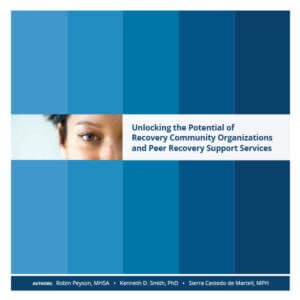Our Publications
Unlocking the Potential of Recovery Community Organizations and Peer Recovery Support Services

Executive Summary
The shift toward recognizing addiction as a chronic disease has placed peer recovery support services in greater focus. Since the 2010 release of the Faces & Voices of Recovery (FVR) report, Addiction Recovery Peer Service Roles: Recovery Management in Health Reform, certified peer specialists delivering recovery services (peer workers) have become key components of interventions designed to improve recovery outcomes. The inclusion of peer workers has become a best practice, and a number of interventions utilizing them demonstrate compelling outcomes. Of course, this progress was built on earlier development of peer recovery support services and a long history of peer based efforts, dating back to the 1800’s, as described well by William White in his 2009 paper on the history, theory, practice and evaluation of peer support in SUD recovery (W. L. White, 2009).
Spurred by efforts to improve the Triple Aim, delivery-system and reimbursement innovations have emerged in the addiction recovery space. Some of these innovations incorporate peer workers as design features. However, these innovations face a wide variety of systemic barriers that constrain their effectiveness and their diffusion across regions. For example, health insurance churning may limit continuity of recovery supports during the full five-year period science suggests is needed for full recovery. Moreover, for those living in low resource communities, recovery capital—the internal and external resources needed to sustain recovery—may be far more challenging to draw upon. Without a long-term strategy to address such inequities, peer recovery support will not realize its potential for transformational impact.
This position paper lays out the key issues underlying the need for action to bring about broad systems change. First, we discuss the emergence of peer workers as distinct from counselors, social workers, and care coordinators. While offering evidence for the beneficial impact of peer recovery workers, we stress the critical need for fidelity to recovery principles and values for maximum effectiveness. A peer-to-peer relationship based on trust and the presence of someone with lived experience during the recovery journey are what make peer workers unique. Trying to match the peer receiving services with the peer coach that best reflects their lived experience, culture, and race is important and points to the need for more diversity in the PRSS delivery field. The peer-to-peer relationship also impacts health at multiple levels of the socioecological model (i.e., at individual, family, community, and societal levels) and has potential not currently actualized.
Second, we survey the variety of reimbursement and financing practices for peer recovery services. In addition to wide variability across states in financing peer recovery services, we find little evidence that reimbursement levels are adequate to cover RCOs’ administrative costs. More importantly, we find that the compensation levels for peer workers are often below the living wage and fail to compensate them for other positive outcomes that are unmeasured, unmeasurable, or ignored by payers. Unfortunately, reimbursement levels are not set based on the actual value that emerges from the delivery of peer recovery support, nor are they based on outcomes. The broad systems change that is needed includes a paradigm shift about the transformational potential of peer workers that matches the science of addiction and the recognition of addiction as a chronic disease. This requires more than just targeting policies and practices governing
reimbursement levels.
Notwithstanding reimbursement policies and practices, we believe that peer workers are systematically undervalued in ways similar to other occupations like childcare and home health care workers. This provided further impetus for considering creative strategies to address what appears to us as a complex social phenomenon. As William White notes , the issue of disproportionate pay for people in recovery has pervaded the modern history of addiction treatment and continues today (Olmstead et al., 2005, 2007).
Third, we summarize some of the trends that can be used as leverage for transformative systems change. This was the foundation for a theory of change that posits that by understanding and leveraging the dynamics emerging from these trends, Recovery Community Organizations (RCOs) can intervene in the complex systems that shape substance use and recovery. By engaging with key stakeholders and promoting a compelling vision for peer workers in recovery ready communities, RCOs can nurture new dynamics that ensure existing trends move toward genuinely transformative systems change. Crucially, this involves RCOs playing a central role in addressing the social determinants of health in coalition with local, regional, and national stakeholders—for example, by building recovery ready communities and advocating on behalf of peer workers.
We identify two leverage points where recovery community leadership can foster greater value, appropriate utilization, and adequate compensation for peer recovery support. Based on our underlying theory of change, we expect these recovery-community-led actions will uplift the peer worker profession, greatly reduce re-occurrence of substance use through peer and other recovery supports, and foster the development of recovery ready communities across the US.
The recovery community cannot do this alone, however. This position paper is a call to action for Faces & Voices of Recovery, RCOs, government agencies, payers, philanthropy, and stakeholders from other sectors to work collaboratively to bring about lasting, transformative change in the U.S. Our recommendations are grouped into four action areas designed to nurture systems change:(1) laws and regulations, (2) organizational capacity-building and community development, (3) workforce development, and (4) leadership development. Over time, these actions can support RCO efforts to shift systems from their current, sub-optimal state to robust recovery-ready communities. We hope our position paper will become a catalyst for reinvigorating the RCO and peer movement and ultimately lead to improved health and well-being for all.
